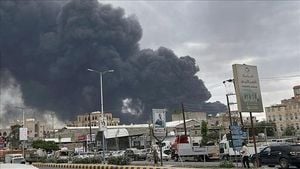Australia's military efforts are under the spotlight as the Australian Navy closely monitors Chinese warships operating near its waters. Recent audio has surfaced, detailing communications between the Australian Navy and Chinese warships as they approached Christmas Island.
The engagements are part of Operation Task Force 107, which has garnered significant attention since the Australian Department of Defence first reported its presence near Australia on February 13, 2025. The task group consists of three Chinese vessels: the Jiangkai-class frigate Hengyang, the Renhai-class cruiser Zunyi, and the Fuchi-class replenishment ship Weishanhu. These ships began their circumnavigation of Australia shortly after affirming their operational capacity.
According to Australian Defence Minister Richard Marles, the Navy has deployed three Anzac-class frigates—HMAS Stuart, HMAS Warramunga, and HMAS Toowoomba—to monitor the movements of these Chinese warships. "From the very moment the task force came within the vicinity of Australia, we have been surveilling its movements," Marles stated during a recent interview. The vessels are approximately 500 kilometers (310 miles) northwest of Perth.
On February 21, the Chinese task force conducted live-fire exercises in the Tasman Sea, between Australia and New Zealand, raising concern within the Australian government. Commercial airlines were diverted from the area as the live-fire exercise was underway. This incident triggered public notifications from the Australian government, emphasizing the need for heightened awareness and monitoring of the situation.
Analysts, such as Malcolm Davis from the Australian Strategic Policy Institute, have interpreted China's naval maneuvers as strategic signaling. "It’s clear China is using this deployment to assert its capabilities and project power beyond its waters," he explained. With the U.S. adopting more isolationist policies, such movements perhaps aim to display China's increasing military assertiveness.
Research from Naval News has traced the path of the Chinese task group, which first became public knowledge when images of the frigate Hengyang were released on February 11, 2025, as it traversed the Torres Strait. Upon entering the Coral Sea, it rendezvoused with the Weishanhu, demonstrating sophisticated naval coordination.
Following the live-fire exercise, surveillance alongside the group continued, with HMAS Arunta shadowing their movements until February 21, when HMNZS Te Kaha, New Zealand’s naval vessel, began its oversight. This live-fire drill, observed by the New Zealand Navy, showcased China's capacity for military exercises at sea waters, putting their operational compliance to the test.
Following exercise events, the task force entered the Great Australian Bight and was last reported moving northward near Perth, with increasing speculation about its potential goals and return itinerary. By March 5, it was confirmed by Marles the group was being shadowed as it moved up Australia’s coast. Just two days later, the situation intensified with reports stating the Chinese Task Force was located 420 nautical miles south of Christmas Island.
This continuous operation by the Chinese is perceived not only as military exercise but also as political maneuvering to intimidate neighboring states, including Australia. Brady, from the University of Canterbury, noted, "China's actions send messages to New Zealand and Australia about potential threats to their air and maritime links."
Despite the evident threat posed by the Chinese military activities, both Australian and New Zealand officials assert these operations are conducted under international law. They reiterated during various media outlets the importance of lawful navigation and military exercises pertinent to their sovereignty. Nevertheless, tensions have escalated due to the overwhelming military presence operating off Australia’s coast.
The Australian public's awareness of the Chinese warships' presence continues to grow, with many citizens concerned about maritime relationships and national security. The task force's operations around Australia have been described by experts as signaling China’s intentions to deploy naval forces beyond its territorial waters regularly, which may challenge established maritime norms.
Looking to the future, as Richard Marles indicated, the Australian Navy's mission remains staunch, stating, "We will continue to stay with them as long as they are within Australian waters." The question remains: how will future engagements evolve with Chinese vessels asserting their military presence within close proximity to Australia? Only time will tell how these naval encounters shape regional dynamics.
The strategic significance of operations like these cannot be overstated. They indicate the delicate balance of power and the importance of international law and diplomatic dialogue, especially within the fiercely contested Indo-Pacific region. The Australian government must navigate these waters carefully as global attention remains focused on the ramifications of military posturing by the People's Liberation Army Navy.
For now, the events around Task Force 107 serve as a reminder of the changing dynamics of international military affairs. The Australian Navy stands ready, committed to monitoring and responding proactively as tensions heighten and the balance of power continues to shift on the global maritime stage.



